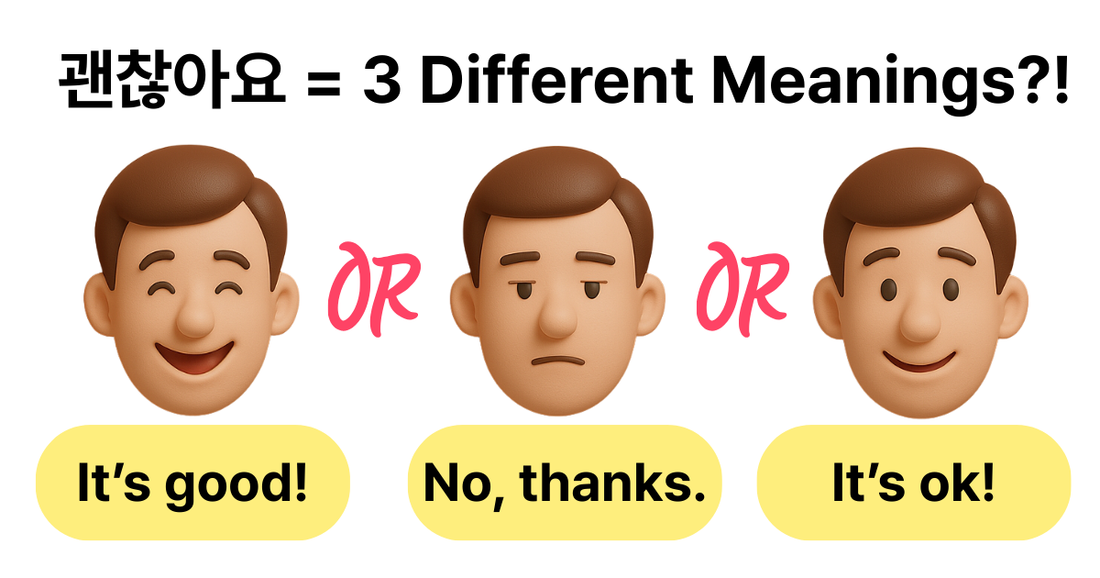
Stop Misusing “괜찮아요”! 3 Real Meanings with Examples.
Share
One of the most frequently used expressions in Korean is:
“괜찮아요” (gwen-chan-a-yo)
It may look simple, but this small phrase can carry very different meanings depending on the situation—and even Koreans sometimes misunderstand it!
A Real-Life Example 🎬
When I ordered food over the phone, the staff told me one dish would take longer.
I said, “아, 그럼 그건 괜찮아요!” meaning “I don’t need it.”
But guess what? They still delivered the dish! 😅
They understood it as “That’s okay. I’ll wait.”
Since then, I always double-check my meaning—even when using this polite phrase.
Let’s break down the 3 main meanings of 괜찮아요, so you can avoid confusion and speak Korean more naturally!
1️⃣ 괜찮아요 = “It’s okay!” / “No problem!”
👉 Used when someone apologizes
In many situations, “괜찮아요” is used to comfort someone who made a mistake.
It’s a kind way to say, “Don’t worry about it.”
✔ Example Sentences
A: “죄송해요! 늦었어요.” (I’m sorry! I’m late.)
B: “괜찮아요! 저도 방금 왔어요.” (It’s okay! I just got here, too.)
A: “이거 떨어뜨렸어요. 미안해요!” (I dropped this. I’m sorry!)
B: “괜찮아요! 다치지만 않았으면 돼요.” (It’s okay! As long as you didn’t get hurt.)
💡 In these cases, “괜찮아요” is used to reassure and forgive.
2️⃣ 괜찮아요 = “No, thanks.” / “I don’t need it.”
👉 Used to politely decline
When someone offers you something, you can say “괜찮아요” to turn it down politely.
But—tone is important! If said too bluntly, it can sound cold.
✔ Example Sentences
A: “더 드실래요?” (Would you like more?)
B: “아니요, 괜찮아요. 배불러요.” (No, thanks. I’m full.)
A: “도와드릴까요?” (Shall I help you?)
B: “괜찮아요! 혼자 할 수 있어요.” (It’s okay. I can do it myself.)
💡 In this context, “괜찮아요” = “I’ll pass” or “I’m good.”
Say it with a smile to keep it friendly 😊
3️⃣ 괜찮아요 = “It’s good!” / “It’s fine.”
👉 Used to express approval or satisfaction
You can also use “괜찮아요” to say that something is acceptable or nice.
✔ Example Sentences
A: “이 옷 어때요?” (How’s this outfit?)
B: “오! 색깔이 괜찮아요!” (Oh! The color looks nice!)
A: “그 영화 재미있었어요?” (Was the movie fun?)
B: “네, 괜찮았어요.” (Yeah, it was okay.)
💡 Be careful—if someone asks, “How does it taste?” and you say “괜찮아요,”
you’re probably saying “It’s okay”—not “It’s delicious.” 😉
Wrap-Up 📝
“괜찮아요” is a super useful Korean phrase—but its meaning changes with context and tone!
Now that you know the difference between:
“It’s okay”
“No, thanks”
“It’s good”
You’ll sound more natural and avoid miscommunication!
💬 Practice time!
Try writing your own sentences using “괜찮아요” in each of the 3 ways in the comments.
📩 Want more Korean tips like this?
Subscribe to our newsletter for weekly Korean expressions, cultural insights, and language-learning stories delivered to your inbox!
